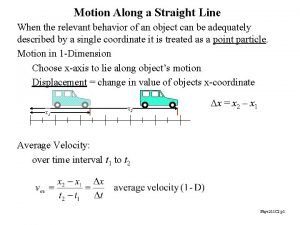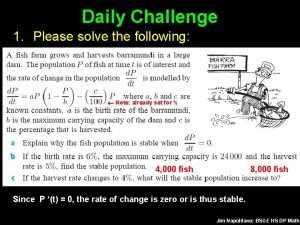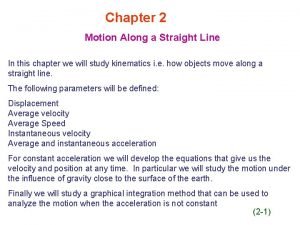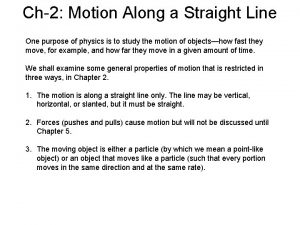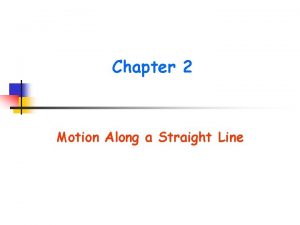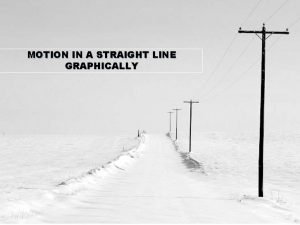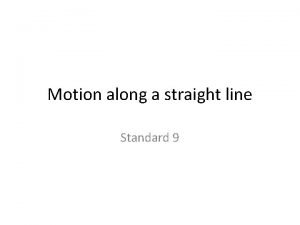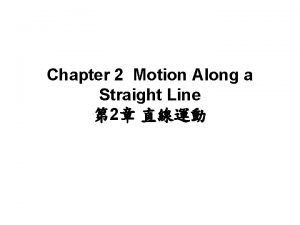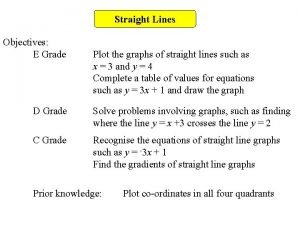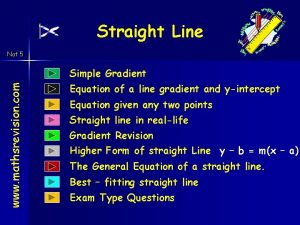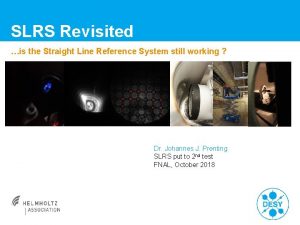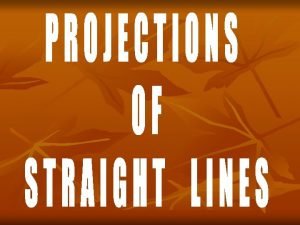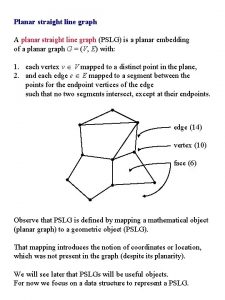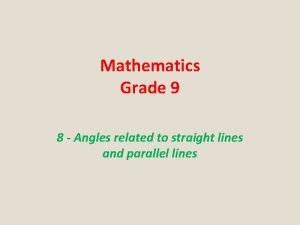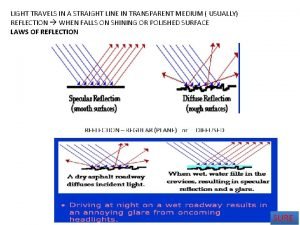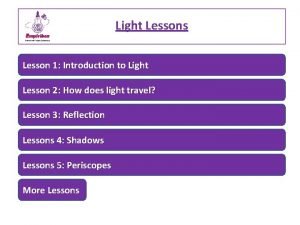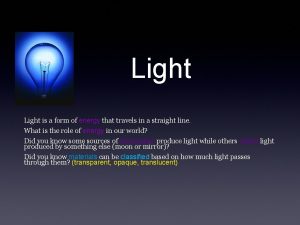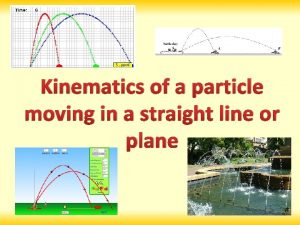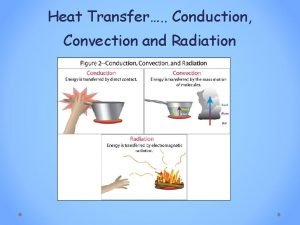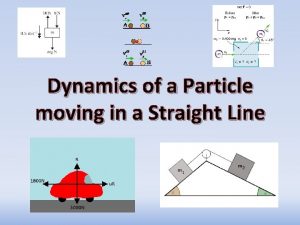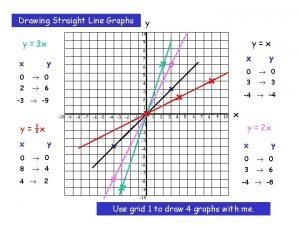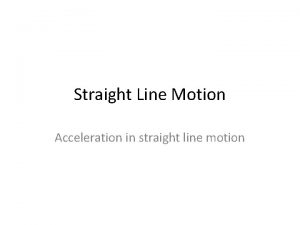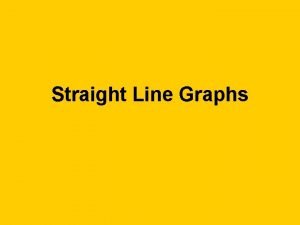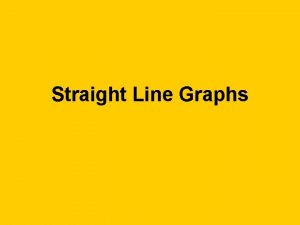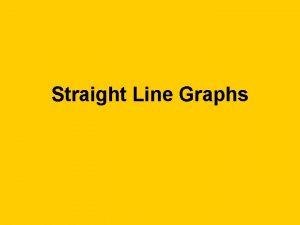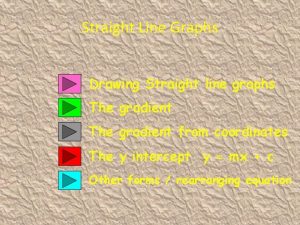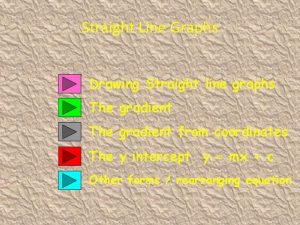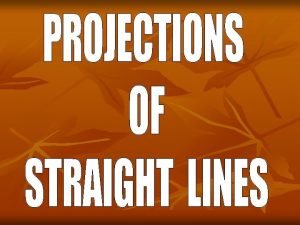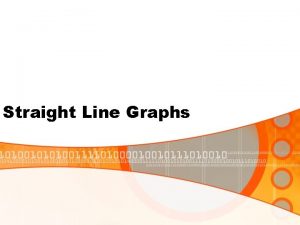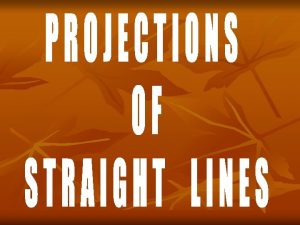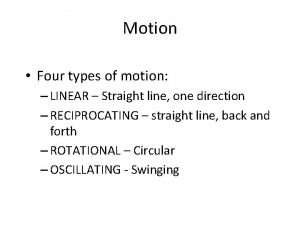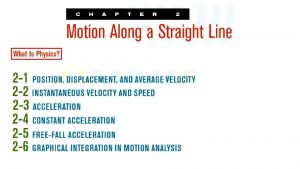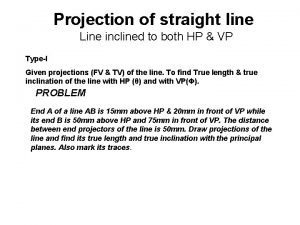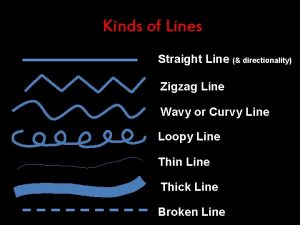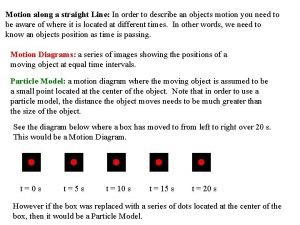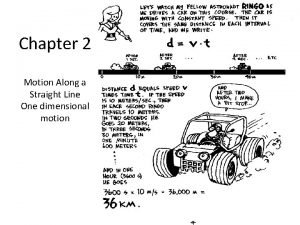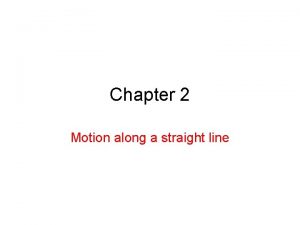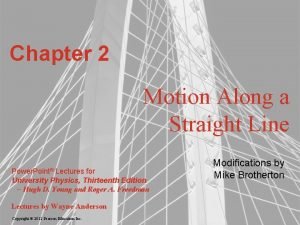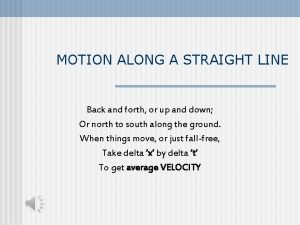1 D Motion motion in a straight line




























- Slides: 28

1 -D Motion -- motion in a straight line

Introductory Concepts scalar vector magnitude, units, direction e. g. , mass (25 kg) weight (140 lbs. ) temperature (83 K) force (48 N )

distance (d) how far object travels -- depends on path taken Peoria displacement (Dx or Dy) the difference between the starting and ending points -- independent of path taken B-N displacement vector Memphis

For position coordinates x 1 and x 2, displacement is. . . Dx = x 2 – x 1 x 2 y 2 For position coordinates y 1 and y 2, displacement is. . . Dy = y 2 – y 1

speed (v) velocity (v) e. g. , 0. 12 m/s e. g. , 0. 023 m/s east x 1, t 1 x 3, t 3 x 2, t 2 d 2 Dx d 1

An Indy car takes 45. 7 s to go once around the 2. 50 -mile track at the Indy 500. Find the… a) …distance traveled. b) …displacement of the car. c) …average speed, in mph. d) …average velocity, in mph.

Graphical Analysis of 1 -D Motion Consider the following position-time curve. position (m) 15 10 5 0 0 slope of curve is: 1 2 3 4 5 6 7 time (s) Slope of a P-t curve at any time is object’s v at that time.

position (m) Find object’s velocity at t = 2. 0 s and at t = 6. 5 s. 15 10 5 0 0 1 2 3 4 5 6 7 (–) sign indicates that the object is moving opposite to how it started (which we assumed was the (+) direction). time (s)

instantaneous velocity: e. g. , police radar constant speed: e. g. , cruise control constant velocity: constant speed in a straight line

acceleration: “how quickly” velocity is changing -- speed up -- slow down -- change direction unit

Car traveling 65 m/s approaches stop sign. Driver applies brakes for 8. 2 s. Find car’s acceleration.

Car traveling 65 m/s slams into tree and stops in 0. 15 s Find car’s (and driver’s) acceleration.

Pygmy goat runs toward a feeding trough with initial velocity 2. 5 m/s. If goat slows down at 0. 42 m/s 2, how long will it take goat to reach trough?

An arrow is accelerated by a bowstring to 36 m/s in 0. 31 s. Find arrow’s acceleration.

Boy runs from inside garage and slides down icy driveway. At top, he moves at 2. 3 m/s. He slides down in 4. 5 s, accelerating at 0. 75 m/s 2. a Dt vi a. How fast is he moving at the bottom?

b. How long is the driveway? Dx Dt = 4. 5 s vi = 2. 3 m/s a = 0. 75 m/s 2 c. Assuming same acceleration, find the time for him to reach the bottom if he starts at the top from rest.

Penguin moves with initial speed 0. 65 m/s. At a later time, he has speed 1. 9 m/s. During this interval, penguin travels 7. 3 m. Find his acceleration. vi vf a=? Dx (derivation given on another slide)

Penguin moves with initial speed 0. 65 m/s. At a later time, he has speed 1. 9 m/s. During this interval, penguin travels 7. 3 m. Find his acceleration. vi = 0. 65 m/s, vf = 1. 9 m/s, Dx = 7. 3 m, a = ?

Linear Regression (Linear Least Squares Fit) a mathematical procedure that gives the “best” straight line through data points that don’t make a straight line . . . y=mx+b x

Using the Linear Regression Equation. . P. . v. . t slope = v . P. t slope = a . . . t 2

Consider a cat on a balance beam… P t An object is in free fall if the “only” force acting on it is gravity. a = g = – 9. 81 m/s 2 v 0 t a 0 t

Free Fall An alarm clock is “fire-escaped” from rest from height 38. 0 m a. How long is clock in the air?

b. Find velocity of clock at impact. c. Find velocity of clock halfway down.

A full beverage can is launched upward with initial velocity 22. 8 m/s. Find… a. …time to get to the top b. …total time in air

c. …maximum height attained (–) sign because g is and Dy is d. …location of can when its speed is half its original speed

Derivation 1 0 when vi = 0… So… ** NOTE: If vf = 0, we get…

Derivation 2 So…

 Motion in straight line
Motion in straight line Motion along a straight line definition
Motion along a straight line definition Straight line motion revisited homework
Straight line motion revisited homework Motion along a straight line
Motion along a straight line It is the motion along a straight line
It is the motion along a straight line Motion along a straight line formulas
Motion along a straight line formulas Straight line motion equations
Straight line motion equations Motion along a straight line formulas
Motion along a straight line formulas Straight-line motion
Straight-line motion Chapter 2 motion along a straight line
Chapter 2 motion along a straight line Adjustable cross staff
Adjustable cross staff Light travels in a straight line
Light travels in a straight line Straight line ppc
Straight line ppc Plotting straight line graphs tes
Plotting straight line graphs tes Gradient formula nat 5
Gradient formula nat 5 Straight line system
Straight line system Straight line definition
Straight line definition Depreciation straight line method
Depreciation straight line method Planar straight line graph
Planar straight line graph Dr frost straight line graphs
Dr frost straight line graphs Grade 9 angles
Grade 9 angles Slimline 750 refractive index
Slimline 750 refractive index Does light travel in a straight line
Does light travel in a straight line It is a form of energy that travels in a straight line
It is a form of energy that travels in a straight line Line of reflection
Line of reflection Kinematics of a particle moving in a straight line answers
Kinematics of a particle moving in a straight line answers Does radiation travels in straight lines
Does radiation travels in straight lines Dynamics of a particle moving in a straight line
Dynamics of a particle moving in a straight line Y=10 graph
Y=10 graph

